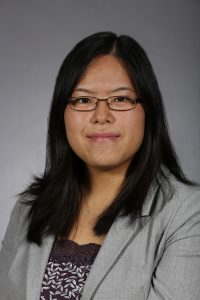
New environmental engineering professor combines microbiology and engineering to address sustainability
When the great Hanshin earthquake hit Japan in 1995, Kaoru Ikuma remembers being without water service in her home near Osaka for more than two months. She says losing access to something as essential as clean water brought the work of environmental engineers that is typically out of public view to the forefront, making her appreciate the importance of the discipline.
The new assistant professor of civil, construction and environmental engineering adds that natural (and manmade) disasters will always be an area where engineers can help bring ideas together to address the issue at hand.
Ikuma uses this perspective when it comes to environmental contamination. Her research combines environmental biology and engineering and explores how to best use microbes to remove contaminants from water.
“Often when people think of microbiology, they link microbes as being detrimental to health,” she says. “The reality is the majority of microbes are extremely useful and absolutely necessary for cleaning up the environment.”
Techniques that incorporate microbes to clean water grabbed Ikuma’s attention when she was an undergraduate student at Virginia Polytechnic Institute and State University. During that time, she worked in an environmental engineering lab performing research in environmental microbiology while she was earning her bachelor’s degree in biology and biochemistry. From there, she she studied environmental sciences and engineering for her master’s degree and environmental engineering for her Ph.D.
Her research has evolved over the years, and she now investigates ways to encourage horizontal gene transfer during bioremediation, which is a treatment that uses microbes to break down and remove contaminants.
“Horizontal gene transfer works much faster than the vertical gene transfer that occurs in humans. The approach allows us to quickly implement and express ideal characteristics within microbes,” she explains. “A big part of our work is to identify and remove roadblocks that exist when we are trying to get the genes to transfer.”
Ikuma is also constructing microbial communities to facilitate biodegradation flow. She says during biodegradation microbes follow a specific pathway while breaking down compounds. “Sometimes this process doesn’t happen in one cell – instead it’s several cells that have to come together at the right place and time. As you can imagine, in nature that can take a long time. If we can figure out what is happening and where, we can deliberately engineer the community to make sure the pathway flows well and fast to treat the contaminants.”
In addition to research, Ikuma enjoys the mentoring aspect of her position. From the students she’s co-teaching in CE 326 – Principles of Environmental Engineering to the graduate students working in her laboratory, she says helping others grow and discover their own path is truly rewarding.
“There are a lot of places environmental engineering can take someone,” she says. “When we’re looking at environmental sustainability, it’s an interdisciplinary problem. Engineers are in the heart of all the sustainability movements, and we have the tools to bring these groups together to move toward a properly sustainable, environmentally conscious society. It’s an important message I want to share with others while working on making those connections with other researchers.”